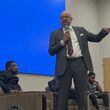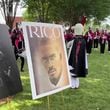Who can be a TSA officer
Pay for TSA officers starts at about $15 an hour. Here are the job requirements:
— 18 or older
— U.S. citizen or U.S. nationa
— Pass drug screening and medical evaluation
— Pass background check and criminal check, with no default on $7,500 or more of delinquent debt
— High school diploma, GED, high school equivalency test or test assessing secondary completion credential OR at least one-year full-time work experience in the security industry, aviation screening or as an X-ray technician.
— Proficient in English language
BRUNSWICK — Nestled in Georgia’s low country sits a federal facility that now plays a key role in the nation’s fight against terrorism in the skies.
As of this year, every new screening officer hired by the Transportation Security Administration goes through two weeks of “basic training” at the Federal Law Enforcement Training Centers in Brunswick.
About 90 other federal agencies train at the 1,600-acre former Naval base that has its own Zip code and includes a mock neighborhood to practice policing, mock courtrooms, 15 firing ranges and an explosives range. It also has dorms and a dining hall.
Customs and Border Protection, the Secret Service, the Bureau of Alcohol, Tobacco and Firearms and federal air marshals train here.
The TSA Academy at the training center creates a single standard for training of incoming officers, replacing the previous hodge-podge of training programs used at different airports across the country.
TSA trainees wear uniforms and sleep in barracks at the former Naval base. Each morning they stand up and recite the agency’s serious, if tongue-twisting, mission: “Protect the nation’s transportation systems to ensure freedom of movement for people and commerce.”
The TSA’s shift to centralized basic training was aimed at fixing problems found in checkpoint security.
Peter Neffenger, a former Coast Guard vice admiral, stepped into the lead position at TSA last year as the agency was in turmoil. A federal audit had found frequent failures to detect mock explosives and weapons during tests.
Neffenger quickly began looking at how to centralize training at the federal facility in Georgia.
“To me, one of the fundamental requirements for an organization is to have a common training base,” Neffenger told The Atlanta Journal-Constitution a month after stepping into his role. “That builds culture, it builds connection and it builds a sense of who you are as an organization.”
He said he wanted to create a “true entry-level academy” by expanding the TSA’s training operation in Brunswick, where it had been sending some supervisors but not all new officers.
The broadened training program launched in January and costs the federal government $2,400 per student.
Pat-down practice
At a mock security checkpoint inside one building, a class of officers practices full pat-downs, giving instruction to passengers and reading X-ray machines. Some trainees pick up a white card from a stack that describes a passenger role to play, such as a handicapped passenger or an ornery traveler in a big rush.
Their role might involve hiding a knife in a waistband or an explosive in a pant leg. The job of the other trainees manning the checkpoint is to practice communicating and keep a difficult passenger from talking their way through the checkpoint with hidden contraband.
“I’m going to have to check your waist,” trainee Jose Mir, from New Orleans, says to a mock passenger. Afterward, he says: “You have to be tactful, because you’re touching people’s parts. A lot of people, as long as you’re letting them know what you’re doing, it’s no surprise.”
In another practice pat-down, trainee Michael Nelson, who will work at an airport in Medford, Ore., says to mock passenger Don Burik: “Sir, you’ve got something on your ankle here.”
“No, there’s nothing there. Just move along,” replied Burik, who is training to become a TSA officer at the Anchorage airport. “I’ve got, like, five minutes,” he says, tapping his watch.
The key, Nelson said: “Remain calm, even though the passenger in this case was irritated, he was agitated. You have to make sure you keep the passenger here” until the screening is complete.
Aside from the training in Brunswick, new TSA officers typically have another two weeks of training specific to their airport’s checkpoints, along with a month of working alongside an experienced officer.
Repetition, team-building
The training allows officers to “make decisions without having to second guess ourselves, through repetition, through team-building,” said Terrence Davison, who lives in Sandy Springs and joined TSA at Hartsfield-Jackson in March. Pat-downs can be “a little challenging at first,” but “once you’re repeatedly doing it, it’s mind over matter. You have a job to do, you’re keeping everybody safe.”
Davison, who had previously worked for an airport contractor and for FEMA, said he was attracted to a TSA job because “you’re kind of still helping people on the home front, but just in a different way.”
TSA has undergone withering criticism for failures, including mismanagement at the agency, security failures, misdeeds by officers such as theft from passenger’s belongings.
Neffenger said TSA officers have “taken on a job that is not always the most popular job to have.”
“I always remind anybody I talk to: Don’t forget that these are people who took the oath of office to do a very challenging mission,” Neffenger said. “It’s truly a no-fail mission. This is one of the hardest missions there is.”
This year, the agency’s image took a serious hit when lines stretched through terminals and were sometimes more than an hour long. Since then, TSA has deployed more officers to the busiest airport such as Hartsfield-Jackson International Airport and started hiring more officers to reduce wait times.
That has kept FLETC busy. Each week, a new group of about 190 new TSA hires begins their training here.
“We still are an agency that has people who come from many, many walks of life and many other types of work,” Neffenger said.
“There’s a couple of things that happen when you send people to training,” Neffenger added. “First of all, you say that you care about them. That’s important. You say that ‘I’m investing in you.’”
Excitement in their faces
“And then, they see other professionals from across the nation training there, and you realize you’re part of this larger effort to protect this nation, and I think that’s exciting. I see it in the faces of the people.”
One of the key challenges is detecting the biggest threat to aviation security: improvised explosive devices, or IEDs. TSA instructors emphasize to new hires that IEDs can be very difficult to detect, in part because they are constantly evolving, and can be made of common household goods.
Some explosives can be molded into different shapes and hidden inside electronics. Some are as thin as a sheet and can be disguised as a letter in an envelope. They can be liquid or solid, granules, powder or have the texture of cake frosting.
“The enemy is constantly looking to attack us,” instructor Bill Morgan tells a class of TSA trainees. “You’re at war. We’re at war. You guys are the front-line troops.”
Willie Gilbreath, a 52-year-old who is training to become a TSA officer at the Grand Rapids, Mich. airport, said checks and balances help ensure security, but acknowledged: “It’s very nerve-wracking. We’re here to protect the country.”
Morgan, the instructor, puts it simply during his class.
“Once a bomb gets on board, that’s the end of it,” he tells the trainees. “When do we find out there’s a bomb on the airplane? When it goes off.”






